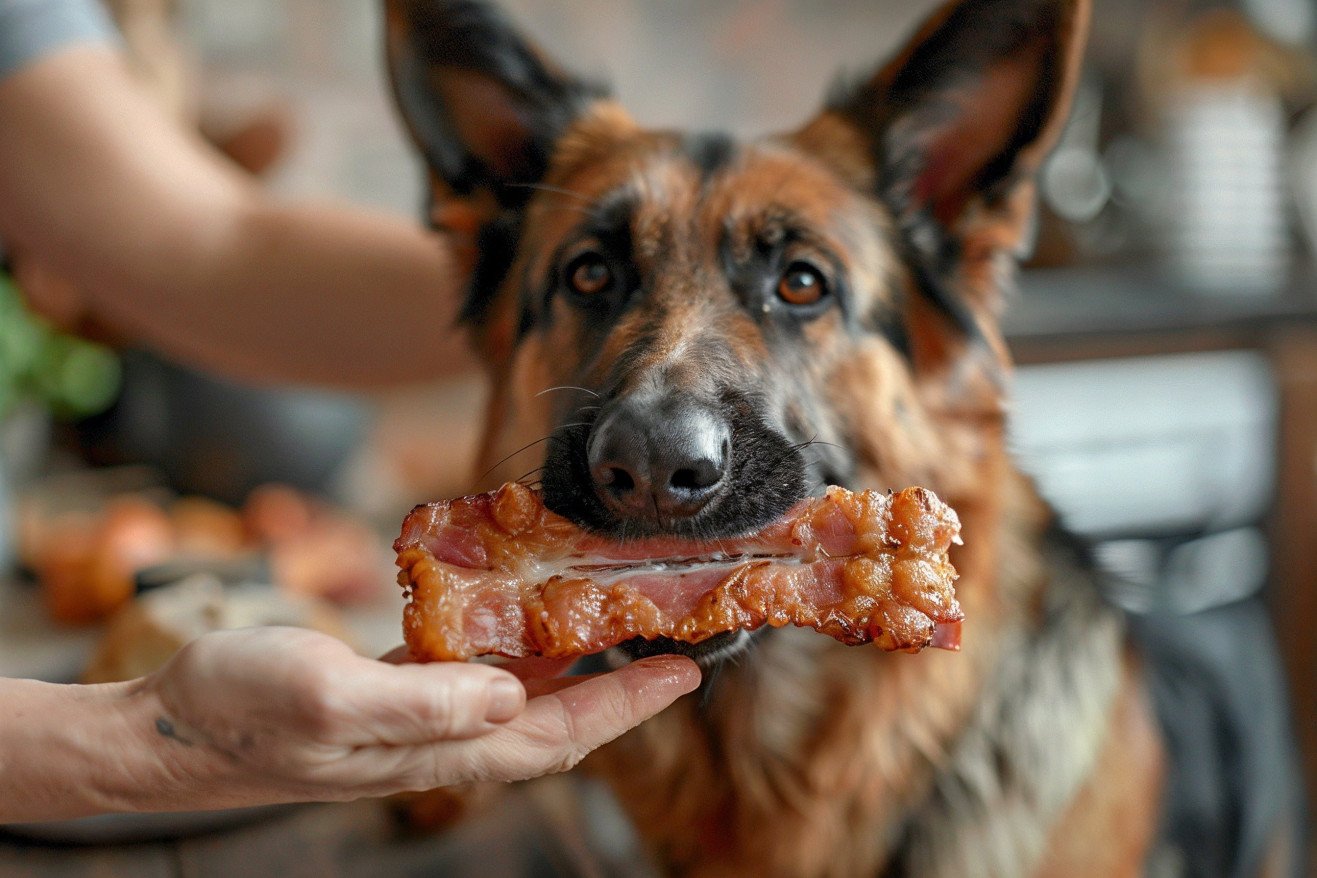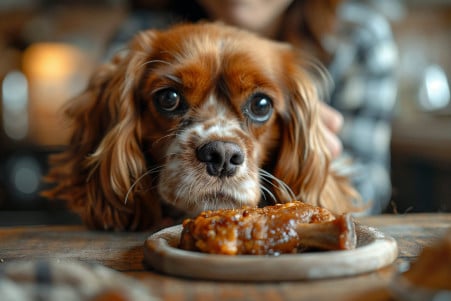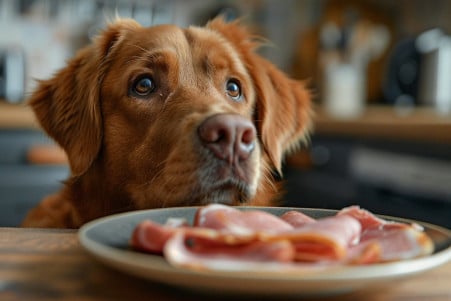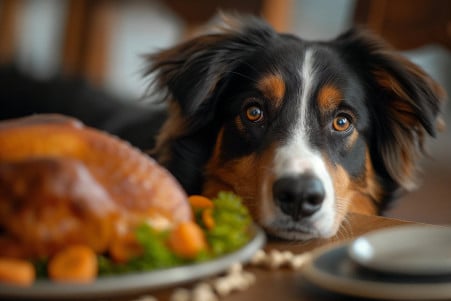Can Dogs Have Ham Bones? A Look at the Dangers
29 March 2024 • Updated 29 March 2024

If you’ve ever found yourself with a leftover ham bone, you may have wondered if it could be a tasty and healthy treat for your dog. While they may be tempting, ham bones can splinter and lead to blockages, choking, or perforations in the gastrointestinal tract. As a result, it’s best to avoid giving your dog ham bones and instead stick to safer chew options that have been approved by your vet.
To get a better idea of what that means, let’s take a look at what veterinary professionals and scientific research have to say about the potential dangers of giving ham bones to dogs. By reviewing case studies, X-rays, and nutritional analyses, you’ll be better equipped to decide whether or not you want to feed your dog ham bones or stay away from them entirely.
Are ham bones safe for dogs?
Why Are Cooked Bones Bad for Dogs?
The primary reason that cooked bones, such as ham bones, are so dangerous for dogs is that they are brittle. According to The Kind Pet, when bones are cooked, they become brittle and prone to splintering, which can cause injuries. These splinters can cause everything from small cuts and scrapes in the mouth and throat to much more serious problems.
One of the most serious issues is the potential for a gastrointestinal blockage. According to The Animal Keeper, bone shards can get stuck in the esophagus, windpipe, stomach or intestines. This can cause extreme pain and, if not treated, can even be life-threatening. The potential for internal punctures and perforations is also extremely serious. According to Animal Emergency Service, when a dog ingests a cooked bone, it can cause internal bleeding if fragments pierce internal organs.
Choking and dental issues are also potential problems that vets warn about. According to the American Kennel Club's expert advice, bone shards are a major choking hazard and can puncture and cut the inside of your dog's mouth. In addition, dogs that chew on hard, cooked bones can easily break their teeth, which can be painful and require expensive dental work.
Because of the potential for everything from minor injuries to life-threatening problems, vets are in agreement that dogs should not be given any type of cooked bones. While it may be tempting to give your dog the leftover ham bone, following this advice can help you avoid unnecessary pain and expensive vet bills.
Safe and Healthy Alternatives to Cooked Bones for Dogs
While cooked bones, including ham bones, are never safe for dogs to eat, there are other alternatives that can provide the same benefits. The Kind Pet notes that raw bones can be helpful for cleaning teeth and providing mental stimulation if they are the right size and if the dog is supervised.
The American Kennel Club's expert advice also suggests that durable dog toys, antlers, and edible chews like bully sticks or yak cheese can be good alternatives to cooked bones because they can help satisfy a dog's natural urge to chew while being less likely to splinter.
When you do introduce a new chew, it's important to do so slowly and under supervision to make sure it's right for your dog. As Dogsee Chew explains, start by letting your dog smell and chew on the new treat for a few minutes before watching for any signs of a negative reaction. This can help your dog's digestive system get used to the new treat and prevent an upset stomach.
By offering a range of safe, long-lasting chews, you can help your dog satisfy their natural urge to chew without putting them at risk of the dangers associated with cooked bones. Your vet can also help you find the best chew toys and treats for your dog based on their size, breed, and chewing style.
What to Do If Your Dog Eats a Ham Bone
If your dog eats a cooked ham bone, it's important to act fast and get advice from a vet. The Dog People by Rover.com warns that you should act quickly, as cooked bones can splinter and cause serious internal damage.
Keep an eye out for symptoms that could indicate a problem, including vomiting, lethargy, constipation, or abdominal pain. The American Kennel Club explains that if your dog is lethargic, constipated, straining to defecate, or has bloody stool, is vomiting, appears bloated in the abdomen, is not eating or is generally uncomfortable, you should take them to the vet right away.
Your vet may choose to wait and see if the bone passes, induce vomiting, or perform surgery based on the specifics of your dog's case. JustAnswer warns that inducing vomiting is not recommended because it can cause further damage from sharp bone fragments. However, your vet may recommend giving your dog white bread or canned pumpkin to help the bone move through their system.
Acting quickly and getting advice from a vet can help prevent serious injuries or blockages. As Vets Now points out that if the foreign object is chewed up, the sharp edges of plastic or bone can pierce the intestine, causing peritonitis (an infection in the abdomen). That's why it's important to get your dog to the vet as soon as possible.
Raw Ham Bones for Dogs
While cooked ham bones are generally agreed to be dangerous for dogs, the safety of raw ham bones is still a topic of discussion. Purina warns that raw ham bones also pose an additional risk as they contain bacteria that are harmful to your dog. On the other hand, Oma's Pride says that raw bones can be a source of important nutrients and mental stimulation for dogs if they are given to dogs in the right way.
Some claim that raw ham bones can help dogs meet their natural need to chew. Oma's Pride notes that raw bones for dogs are essential because they support digestion, clean teeth, mentally stimulate, strengthen the jaw and mouth, ease anxiety, and provide essential nutrients like calcium. However, others warn that raw pork bones can still lead to digestive problems or even dental damage.
As with any raw bone, it's important to supervise your dog when they're chewing on a raw ham bone and make sure that the bone is the right size for your dog. Oma's Pride says that choking, splintering, and blockages can occur with raw bones and advises against giving dogs cooked, smoked, or heat-processed bones. In the end, the safety of raw ham bones is still up for debate in the dog-owning community.
Summary: Keeping Your Dog Safe
Cooked ham bones and other cooked bones are not safe for dogs and should be avoided at all costs due to the many risks associated with them, including obstructions, perforations, and choking hazards.
Safer chew alternatives, such as raw bones (when given under supervision), durable toys, and edible chews like bully sticks or yak cheese, can provide similar benefits without the same level of risk.
If your dog accidentally ingests a cooked bone, seek prompt veterinary advice to prevent potential complications. When introducing new chew items, do so gradually and under supervision to ensure they are suitable for your dog.


